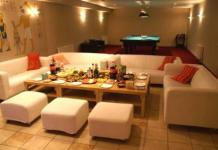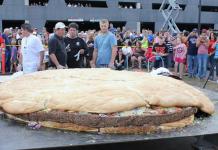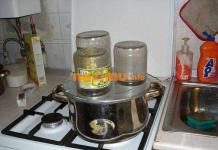The most important thing for an Indian is family, and for a family, the most important thing is home. It is a central place in the life of an Indian family, which is given great attention and love. It is extremely difficult for Indians to part with their ancestral homes and sell them only as a last resort. The connection with the house, the land on which he stands, is almost sacred. Wherever an Indian lives, he will always visit the family home with pride and joy. The young man will either or will come regularly if he settles far away. And the girl, having got married, will run to her parents' house at every opportunity.
Like many years ago, Indians prefer to live in large families. The owner with his wife, his sons with their wives and children, some poor relatives or single family members. About 15 people are easily recruited. Big family - big house... When Indians proudly talk about their 10-room house, believe them. This is quite realistic. It's just worth remembering that 5 families can live in these ten rooms. Each family may have a separate entrance. It turns out such a mini-multi-apartment option. And the immediate family (parents, brothers and sisters) of a boastful storyteller may have, for example, only 2 rooms.
In the center of the house or in front of it, a common courtyard is necessarily arranged, from which corridors and doors depart. If the family is wealthy, it will be marbled and decorated. In a simple family - it is concreted, well, and in extreme cases, just clay or earthen. Here family members can gather, hold joint ceremonies, relax or work, store something, dry clothes. An Indian traditional bed made of lightweight wood frame and stretched straps can be effortlessly carried out and back if you want to lie down in the fresh air. The courtyard is perfect for such a holiday. In hot weather, Indians can stay here all night if the rooms are not air-conditioned. In richer houses there is also an internal common living room. In simple houses, any of the best rooms will play its role.
Another interesting place of the Indian house is the roof. Flat, concreted, with sides or railings. The roof is as popular as the common courtyard. Here they relax, and admire the surrounding views, and dry crops, and cook, and. It's great that the climate and conditions allow Indians to make such roofs. Such a huge territory turns out! We would probably have such a roof collapsed under the snow.
The traditional Indian home has cold marble, tile, concrete floors. Rugs are available, but rarely. Mostly wicker mats, and they are spread when you need to sit on the floor, for a ceremony, for example. Indians are accustomed to walking barefoot in cold, even icy conditions. It’s not very convenient for foreigners. Taking into account the fact that it is customary to take off your shoes before entering the house, and usually no one offers slippers. The walls and ceiling are plastered and painted. Most often I came across white, yellow, green and pink colors walls. Storage spaces - shelves and cabinets - are made right in the walls and go inside like niches. They can be draped with curtains or opened and lined with figurines, picture frames, peacock feathers and other decorative elements. On a wide shelf, located high under the ceiling, they put things that are rarely used, plus boxes, bags or suitcases with clothes. It took something - climbed up, took out a huge suitcase, took out the thing, put it back. What is worn every day is hung on hooks driven into the wall. The beds of the Indians are low, rather large and hard. They sleep here at night, and during the day they lie, sit, eat, work. Poor Indians often sleep several people on a bed, so they don't bother with bedding. I put a sheet on and sleep until the visible dirt appears. They cover themselves with any blanket or blanket, the same pillow for sleeping and for sitting, leaning against it during the day, even the owner, even the guest. Tali with food are placed directly on the bed. The Indian sits down next to him in Turkish and eats.
In simple houses, there is very little furniture. Often everything ends with a bed and an in-wall wardrobe. Sometimes there are cheap bedside tables and some shabby armchair. In richer houses there is very beautiful traditional furniture - sofas, armchairs, wardrobes, bedside tables. Several times I saw something like large iron safes. Apparently for storing gold. Signs that the family is doing well are the presence of a refrigerator (first of all), a TV (second) and an air conditioner. Regardless of whether there is air conditioning or not, there will be a fan hanging from the ceiling.
Indians have small windows, usually barred, often without glass at all. And there may not be a window, also an option. On a sunny day, the rooms look sad and uncomfortable. But Indians, unlike us, are not interested in the sun. They have too much of it. They will sit down in a dim, but cool room, turn on the TV - and here it is, happiness.
The unpleasant consequence of glassless windows and loose doors without thresholds is that you cannot hope to live in a room alone. Pets will definitely come to you. Flies, beetles, grasshoppers and all kinds of ground beetles only add something exotic. The lizards that crawl on the walls and sit under the ceiling throughout Asia are even loved by many (although the Indians are afraid of them and consider them poisonous). But when we found 3 small scorpions in the room, it was no longer a laughing matter. The house stood in nature, and the owner was repairing the concrete courtyard, at the end of which he carefully filled it with water. Here the poor fellows have climbed in all directions. And to us, for sure, they crawled under the door.
When organizing their home, Indians think of practicality, not beauty. Furniture can be very old, strange, awkward. The main thing is that it fulfills its purpose. Although, paintings, posters, figurines, of course, are also available. But the poster, for example, can be glued to the wall with crooked pieces of newspaper, and the figurines are covered with garlands of hanging wires. Indians do not bother about ideality and accuracy. As well as the integrity of the picture. They will not pay attention to the wires, even their eyes will not linger on them. The main thing is to have everything you need, then they are proud of the room. You can sleep on a bed, which means a good bed. The tablecloth on the table is stained - so what, it was washed. The main thing is that the table is closed and kind of dressed up.
In Indian cuisine, people usually don't eat like we do. The simplest version of an old traditional kitchen or just a rustic one is the shelves for storing dishes and food and that's it. Cook right on the floor. If this is a village, a fire can be used for cooking and frying, or a gas burner. The richer and more modern houses already have countertops or tables and gas stoves. Even if the family has electric stove- nowhere without a gas burner. But how can you cook chapatis without living fire? I will not take into account the houses of the capital, but in provincial and rural India, apart from the refrigerator in the kitchen, there is little that can be found from technology. There was a mixer and a toaster. And so - all by hand, the old fashioned way.
The peculiarity of the average Indian bathroom is that it is all flooded with water. For some reason, they do not consider it necessary to make a separate place for the shower so that the main floor and toilet are dry. The shower can stick out completely from anywhere and fill the entire territory. Very often there is no running water in Indian homes. Water is drawn from a family well or from a common street pump. Then they wash themselves from buckets, pouring water from a special plastic mug. Even if there is a shower, a bucket and a mug, you will find below 4 stars in any house and hotel. And quite a large part of Indians would prefer to first collect water in a bucket, and then wash from there, rather than stand in the shower. I have been in bathrooms in both poor and rich houses. In my opinion, everything is not comfortable enough, there is not enough furniture and some details for comfort. You don't know how to arrange clothes and things so that nothing falls, does not get wet, it is convenient to get it out. One gets the impression that the Indians first do something (hang, drive in, position relative to each other),. Or they don’t think at all.
Country houses have a special exoticism. There may not be a bathroom at all, as well as a toilet. There is a concrete fence in the yard, two- or three-walled, rather low, without a door, inside which there are buckets and basins of water and there is a drain in the corner. Here you can wash, wash dishes. Once I was visiting in a deep village. When asked where the toilet was, they showed me in the field. There was a day. Peasants scurried across the field. Rare dry bushes swayed in the wind. Seeing the sadness on my face, the owner took pity and pointed to the fence. So, when you see Indians sitting here and there along the fields and roads in the morning - women, men, children, with a mug or bottle of water - do not be surprised and do not expect embarrassment. This is their culture and life.
In a well-to-do house, it is considered decent to have a bathroom for each room and some common one for guests and servants.
One more thing - you shouldn't always count on hot water. Wealthy families have boilers, while the rest, of which there are many more, have a black barrel on the roof, which is heated by the hot sun. But if the sun is not enough or someone has already drained the water, the Indians, not in the least upset, will wash themselves cold.
I was visiting a modern apartment. Almost everything, a Skyscraper in a new area, is clean and not crowded, an Indian-style shabby elevator and a not very well-kept concrete hall. And inside is an ordinary apartment with a modern kitchen and furniture. Only the obligatory central living room, from which there are doors, 3 bathrooms for 3 rooms and more east in the interior.
It doesn't matter whether the family is rich or poor, whether it is an apartment or a rural house, whether there is a TV set or even no refrigerator. In every house, every family there will definitely be a mini-temple or a mini-altar for the gods. A shelf or corner where figurines and pictures with deities are located. Here ceremonies are performed, offerings are brought here. This place is the best, cleanest and most respected in the house.
If a large family lives in the house, it is always noisy, fun, some guests flicker in. Someone is preparing something, someone is arguing about something. People close to the family may come without warning on short visits. It is not necessary to warn about your arrival if you enter the house. The doors of the house are open to visitors during the day. It is difficult to dream of peace, silence and solitude. But the Indians are not embarrassed by this. Who wants to sleep - fell and sleeps, not paying attention to any noise. They are always cleaned in the morning. There is no concept of personal space and privacy. Apparently, this is why there are so many hermits and yogis in India - those who are tired of the Indian hustle and bustle!
I visit India quite often - this is, so to speak, my real "illness" since childhood. And every time I visit the Indians with great pleasure. I am truly fascinated by the architecture and interiors of their houses, cheerful disposition, "Russian" hospitality and generosity of soul.
Most of the houses of Indian residents, in this case, we are not talking about the poor, but about the middle class, are planned almost like a blueprint and are designed in the same style.
As a rule, their dwelling is a fairly spacious two-story house, the facades of which are literally hung with balconies. The Indians hang linen on them, and the sudras (peasants) dry cow's ... ahem, cakes, so that later they can make incense from them or fertilize the earth.
The courtyard is usually small and cozy, from the outside there are flowers and trees, and from the "end" there is a household where vegetables are cut right on the floor or coconuts are cut, washed, rubbing the linen with hands and beating it with weighty stones.
Their entrance doors are impressive, beautiful, decorated with various religious inscriptions in Sanskrit, many of them hang a bell - it is believed that if you enter a house under this ringing, evil spirits get scared and disappear.
There are no hallways, even in the apartments. You go in and immediately find yourself in the living room, and you need to take off your shoes outside the threshold, on the street. In houses on staircases Rows of shoes can be seen next to the front door. It seems that no one steals, but it is better to go on a visit in cheap sandals out of harm's way, so as not to tempt people and monkeys who strive to steal everything that is bad.
Kitchens in Indian homes smoothly flow into the dining-living room, representing one space. Impressive marble staircases to the second floor, spacious rooms with large windows and an abundance of sunlight. In every house there is necessarily a room called pujarum - an altar room, where the gods are worshiped, food is offered to them, mantras are chanted and stotras (hymns) are recited. The doors to the pujarum are usually double, imposing and also with a bell.
But the bathrooms in India are very peculiar, so to speak, for an amateur. No baths for you - just a shower, and a cold one, and the water falls right on the stone floor, flowing out into the hole in the corner. It's cold to wash in the morning - brrr, but during the day the pipes heat up and you can wash normally. Europeans mainly heat water in buckets with large heaters that are sold at every turn.
I saw normal toilets only in expensive hotels in Delhi, in houses and apartments the flush is organized in a special way - you turn the faucet in the wall, and water flows from the tank, the pressure is weak, which always made me angry. In general, I will not delve into this topic, so everything is clear.
The Indians have little furniture, and the houses are not burdened with excessive decor. Simplicity and functionality rule. Sofa, tables, chairs, beds, simple wardrobes and no washing machines with microwaves! But laptops can be seen even in villages - civilization, however!
Once I was visiting in a remote South Indian village, with very wealthy Indians. The decor is the same, but the abundance of textiles amazed - napkins, towels, embroidered bedspreads on the beds and behind the house - two girls of 13 years old who rub coconut in a "coconut", I even photographed this miracle.
Some of my friends after India made a redevelopment in the apartment in the traditional Indian style, however, they decided not to change the toilet bowl, not to screw the faucet into the wall, left the bathtub and did not cut off the hot water. Yes, and take off their shoes in the apartment.
As I come to visit them - such nostalgia rolls over ...
Probably the first association that arises at the mere mention of such a house is the Great Wall of China. Indeed, the walls are similar, only the wall in India is not so big and cannot boast of such a long history.

The Indian house is surrounded by a wall made of laterite, a stone widely used in Kerala architecture. It not only looks attractive, but also environmentally friendly. A three-storey house in one of the regions of India looks beautiful and unusual.

The entrance to the house, the courtyard, the building itself - the “great” wall surrounds the entire space. The house occupies a large area with a beautiful patio, courts and a swimming pool. Upon entering the house, the first thing that opens to the eye is the dining room and living room. A corridor from the dining room leads directly to the bedroom. Behind the dining room is the kitchen, which overlooks the badminton court. The interior of the house pleasantly surprises: minimalist, but stylish and cozy.

The wall creates an atmosphere of protection and reassurance around the home. Various materials are used in landscape design: lawn grass, stone, concrete. A long driveway, walls, concrete paths, bamboo plants: everything looks harmonious and goes well with each other.

The badminton court is located in the backyard of the house.

A green lawn, a multi-level facade of the house - everything looks stylish and elegant.

Spacious living room with a minimum of decor and beautiful wooden floors. The centerpiece of the interior decor is a small sculpture on a glass coffee table.

Bedroom with a minimum of furniture and decorative items. Bed, window and LCD TV on the wall - everything you need is here.

Top floor. Bedroom with three little pink beds for girls. Vaulted ceiling and blinds at the top of the windows.

A special room for watching movies. Such a "home cinema". Black walls and black sofas give the impression of being inside the movie while watching a movie.

A corridor with white walls and round lamps.

The bathroom is finished in shades of white and gray. Particularly noteworthy is the wood-paneled door, which brings creativity to the room.

A truly unique building, impressive in both its layout and design. Ferns, banana trees and other tropical plants grow in the courtyard. The interior design looks impressive too. Corridors with large round windows and lamps of the same shape fill the room with light. In the design of the ceiling, both flat slabs and vaults of various shapes were used. Such a house is a vivid embodiment of the proverb "My home is my fortress." And you can't argue with that.
Indian style in the interior is a unique combination of simple shapes and lines, modesty and even asceticism with sophistication and delicate taste. The design of an apartment or any other room is complemented by golden objects, luxurious decor, elegant inlaid and carved furniture. These are not all but essential parts of Indian interior design style. The study of oriental sophistication is the main purpose of today's article, as we want to understand what is so special about decorating an Indian home.
The room, decorated in Indian style, includes national ornaments, rich textures and magnificent drawings. This kind of interior can often be seen in movies or photographs.

General characteristics of the Indian style
Exists great importance attached to the spiritual side of life, religious concepts and objects form the basis of orderly life in India. A house dominated by Indian design is sure to be saturated with orange, crimson, turquoise hues, and their tones are rarely found elsewhere.

The pieces of furniture that make up the interior of the apartment are preferable to be low and are made by hand from teak (solid wood). Beds and sofas should be comfortable and soft, cozy for rest and sleep.
An Indian home may basically consist of just three or four basic pieces of furniture, but careful consideration should be given to their selection. Interior items made for oneself should be combined in texture, style and always in color.

The Indian style can be recognized in the photo and by its characteristic feature: pieces of furniture are easily transformed. Screens, doors, blinds, chairs and tables can easily change their purpose as needed. The decor of an apartment in India must necessarily contain elements of ivory, teak, wrought iron.
The interior in the Indian style is represented by products made of mother-of-pearl, brass, and silver. Design often involves decorating rooms with colorful feathers. People in India usually do woodcarving, embossing and fine metal objects with their own hands. The house (or room), corresponding to the Indian style, is necessarily inlaid with bronze, silver, colored stones.

Indian modern apartment design also has special accessories:
- paintings where scenes from the life of Buddha are necessarily present;
- screens decorated with pictures or photographs of female figures;
- sculptures of a religious nature (the Indian style is unthinkable without them);
- clay figurines of birds and animals, multi-colored candles of various shapes (usually a house in India is richly decorated with such things);
- ringing trinkets suspended from the door or in the window opening (at least characteristic feature Indian apartment);
- hookah (known in India from antiquity to the present day, it is necessarily included in any decor);
- fresh flowers or handmade from the brightest natural materials(it should be remembered that the Indian interior is largely "floristic").

Details in interior design
Europeans often represent Indian style in their interiors as a mixture of bright colors, fabrics, figurines, many mirrors, candles and other attributes, some of which are handmade. Such a design can be seen in the photo, but excessive variety is not an entirely correct idea of what Indian design is.

The Indian house and its design really look colorful, but this riot of colors is not luscious, but thoughtfully and correctly placed. A real Indian home attracts with its warmth, home decor, coziness and softness. The interior attracts, first of all, with its open hospitality.
The Indian interior requires special attention to color compositions, since it is the shades that play the leading role in the decoration. Any little thing is analyzed - how colors interact, how they combine with furniture and objects in the room. The color scheme should not negatively affect the mood of the owners.
Indian interior is the right choice of color and pattern. Very popular in Indian style is the color of butternut squash pulp. It is a bright orange reddish hue. An Indian contemporary home can also contain a bold palette of all hues.
In the interiors of this country, a juicy bright green color and all its shades are widely used. A room with a predominance of red tones is often found in photographs of housing in India.

The Indian-style interior provides for a special wall design. The huge areas provide an opportunity for artistic experimentation. In the Indian interior, the walls are painted in gold, yellow, turquoise, light green. However, this brightness is in place. The style can be fully observed if you use warm or neutral shades, then the decor can be highlighted in a sandy, dark brown, delicate orange shade.

The interior must contain printed fabrics with bright floral ornaments, drawings of birds and animals. A traditional house in India is certainly adorned with a special teardrop-shaped ornamentation. This pattern is called "Indian cucumber".
Printed fabrics with patterns are used as bedspreads. Of these, pillows, curtains, curtains, drapes are usually sewn. The correct use of fabrics allows you to quickly decorate your home in a traditional Indian style.
In the design of an Indian house, the variety of arches carries a special decorative load. Mirrors, chair backs, sofas and beds are decorated with this element. The shapes of the furniture are simple but richly decorated.
Furniture design must reflect painstaking orientation and patience. Decorative interior items are varnished, decorated with ivory, black mother-of-pearl or openwork carving. Indian style in the interior should contain these minor, but important for the general direction of the details.

Furniture in an Indian home
For seating, round chairs with cushions but no backs, low stools and benches are used. Back in the 19th century, unpretentious furniture from India was popular in European countries. A low bed (frame with a wicker bed for lying), which allows you to maintain a traditional style, is widely used in the interior. The design will look harmonious if the main pieces of furniture are combined in their shades.

The following pieces of furniture are typical for the Indian interior:
- a low coffee table should be present in the interior. It is characterized by straight, massive legs, carved edges and most often has a glass surface;
- the interior of any home in India is unthinkable without a narrow and low cabinet with doors. Decorate doors with metal or wood lattice inserts;
- the bedside table is also the main detail of the interior. Painting the bedside table with figures of horses, elephants, girls in traditional clothes or sketches from the life of the gods - that's what is relevant for this style;
- the interior looks good if it has a carved screen or screen;
- figurines of animals made from natural materials must be present in the interior. Most often, in most Indian houses you can see miniature sacred cows, crocodiles, snakes, antelopes, elephants.
India had no shortage of timber or clay suitable for making bricks, so there were almost no stone buildings. Already in antiquity, houses were built on several floors with light courtyards, long colonnades and magnificent terraces. There was a sewage system in Indian dwellings. In the northern part of India, houses were built from palm trees, while in the south they used bamboo. Only the upper floors were sometimes built of raw or baked bricks.
The entrance to the Indian house led up the steps past the gatekeeper's room through the passage room to the central courtyard, through which all rooms on the first and second floors were illuminated. The courtyard was paved with bricks and a drainage channel ran under it. There was a well in one of the rooms on the first floor. The courtyard was decorated with a gallery on wooden pillars. Side wings, balconies and verandas on the second floor were sometimes attached to the house. From the first floor to the second, stairs led to the living rooms.
The roof was flat, usually with a large overhang, supported by carved columns mounted on a low stone wall along the façade. The roof was tiled. Outside, the walls were painted or covered with a hard shiny glaze. Ceilings were usually built flat on wooden beams, using false vaults and arches. The floors were paved with bricks. The houses had sewerage, plumbing, heating, and a garbage chute. They withstood the long rainy season with ease.
The painted threshold of the house was always swept clean and even sprayed with water. The arch of the entrance was lined with ivory, with jasmine branches hanging from it towards the entrance. The passage was strewn with fragrant flowers. The halls and galleries of the courtyard were laid out with white alabaster. One of the courtyards of the house was intended for animals - oxen, horses, elephants and monkeys, which, as the Hindus believed, protected the house from diseases. Another courtyard was the reception area. There were luxurious seats and tables, and beautiful vessels filled with water were hung on the walls to freshen the air. The third courtyard served as a kitchen, and the servants were also housed here.
The rooms of the Indian house were small, without windows, with holes in the ceiling for light and air. The interior of the house was divided by columns, light partitions, and carpets. A room for ritual ablutions was arranged in the house. The bathroom was entirely tiled in brick with mosaic floors and a beautiful perimeter border. The Hindus poured themselves from vessels, and then the water flowed into the holes in the floor. The water lines were built from ceramic pipes with wide ends, which made it easier to compact the sections with asphalt to avoid leaks. The toilets were neatly stacked with bricks and had wooden seats. Through the gutters, sewage fell into sewers and cesspools. In the lavatory there was a large vessel with water and an earthen ladle for draining the sewage. The houses of the Hindus were well-equipped already in antiquity.
Only wealthy people had furniture. Rooms were furnished with carpeted sofas, tables, stools, drawers and chests. The Indians did not know large tables; for feasts they set up small tables with rice and herbs. Backless chairs or stools with cushions were known. The stools had round and rectangular seats on which pillows were placed.
The beautifully carved legs were varnished. The seats could be wicker. The sitting position of the Indians was uncomfortable: they crossed their legs under them, half squatted with their left leg tucked in. The nobles sat on throne-type chairs made of fig tree. The chairs were upholstered with expensive fabric.
The beds were made with wicker lying planes, low, on four legs, with supports passed through them. All furniture was made of wood: from hard teak to light bamboo. They also made furniture from bent wood.
Furniture was decorated with tortoiseshell, ivory, precious metals, precious stones... To decorate it, they used the technique of colored varnishing, Bombay mosaics of ebony, mother of pearl and ivory, openwork carving. The decorative Indian style again became interesting to Europe in the 19th century.
The Indians had no shortage of raw materials, so they developed crafts and had a variety of utensils. They made dishes of copper, did not forge, but poured them into molds, which made the dishes fragile and massive. The dishes were unadorned and kept in niches in the walls. They did not know how to make glassware, so it was imported. On the other hand, vessels made of lime spar and stone have been made since antiquity. Luxury items were copper washbasins, mirrors and toiletry bottles. Lamps in the form of female figurines served as objects of worship at the same time. Images of birds, animals, fish and plants on utensils, according to the Hindus, drove away evil spirits.
HOUSING OF THE INDIAN CASTS
In the Middle Ages, Indian dwellings absorbed the features of Arab and Chinese architecture, which was firmly based on local traditions and natural conditions. In Indian housing, the influence of the castes was clearly visible. Shudras could build houses only from clay, reeds and bamboo, no higher than one floor. The palaces were built from durable local granite, a dark green chlorite stone that was easily carved. The stone was combined with brick. The upper floors were made of wood and plastered.
Most Indian houses were covered with plaster to keep out the heat and moisture. The walls of the houses were coated with clay or lime mixed with cow dung. The buildings were covered with bright colored paintings. In the conditions of monsoon downpours, much attention was paid to open courtyards, terraces and pavilions. The roof was made with bamboo slopes and a thick layer of reed or shingles. The walls were made of bricks, tiles, the towers on the walls were made of wood and bamboo. The houses had wooden balconies and terraces.
The upper floors were residential. The windows were covered with wooden or alabaster bars. Cornices, windows, balconies facing the street were decorated with carvings. The houses have retained their traditional oriental layout: a courtyard surrounded by galleries, richly carved brackets above the lower floors, and balconies.
In their villages, the knights of medieval India - the Rajputs - built fortified fortified houses with thick walls, turrets, and entrance gates. The windows were carved stone lattices: you could see from the house, but not from the street. The outer wall had an entrance gate to the north or east, as these directions were considered favorable for entry and exit. The entrance gate was made of stone and had a gable roof made of tiles. They found it in the yard. Their main decoration is wall painting, gilding, columns of valuable types of stone, carved screens and low stools in the ladies' quarters. Houses were decorated with mirrors, ceramics, soft carpets. Each house had a shish-mahal - a special crystal or glass hall. All its walls were decorated with glass or crystal mosaics - colored or mirrored.
GARDENS ON WATER
Since ancient times, water gardens have been built in India. They were made on rafts attached to poles driven into the bottom of the reservoir. The rafts were covered with earth from the bottom of the lake, and a reed fence was fenced around the perimeter.
Bamboo, palms, cypress, willow, poplar, plane tree grew in India. From fruit trees apple trees, figs, mangoes, coconut trees, bananas, cherries, plums, pomegranates, peaches were grown in the gardens; citrus fruits - lemons, oranges, tangerines. Flower cultures in India were represented by daffodils, roses, poppies, delphiniums, lilies, lotuses, lilacs, tulips, irises.
Rajpur houses and the walls around them were covered with lime whitewash, and the plaster was painted with colored mineral paints. They depicted elephants, flowers, ornaments, jewelry-amulets, processions of rajas with courtiers, processions of court ladies, plots of ancient Indian myths and epics. Lattices on windows, balustrades of balconies and screens were made of stone. Houses were also decorated with fine wooden carvings. The lower stone floor was used to house pets and agricultural implements, the upper wooden floor was used for housing. The female half was separated.
Jasmine and roses were incredibly popular. They were planted in rectangular and round flower beds, and were also in the form of octagonal stars. Gardens in the Middle Ages were built on terraces protected by mountains, foothills and other uneven terrain. They were regular. The gardens were built according to the Persian principle of shahar-bagh, according to which the site was divided into four parts. Water channels, symbolizing the four rivers of paradise, divided the entire territory into four small paradise gardens, which were divided into parterre beds. In the center of the garden, they built a gazebo, pavilion or other architectural structures... The palaces in the gardens did not have glass, so nature penetrated into the space of the palace. He merged with her. Silk hammocks were hung in the garden, swimming pools with colored marble bottom were arranged. The alleys were lined with marble-lined canals and rows of fountains. Flower beds ran along the canals.
FROM TENTOR TO ARABIAN HOUSE
In ancient times, camel herds provided the Arabs with material for the construction of a mobile home. Housing was supposed to be collapsible for the Arabs, and it could be easily transported. One of these dwellings is a tent or marquee. The skeleton of such a dwelling consisted of three goats - poles, placed parallel to one another, higher and wider in the middle, smaller on the sides. From above, such a frame was covered with a canopy made of dense felt of camel or goat hair. The canopies were monochrome, dark or striped. The ropes were made from camel skin belts or camel hair.
Poor Arabs made tents from intertwined palm branches or from thin poles covered with felt. There were also conical huts made of poles, tied at the top with belts and covered with leather.
The great tents of the Arabs were divided into three parts. There were male and female halves in the tent, as well as a portion intended for servants and small livestock. Sometimes the women's tent was set up separately. The wealthy Bedouins usually had several tents. In large encampments, the number of tents reached eight hundred. They were lined up in a circle or pulled in one line along the river and placed in rows of three or four tents. The extreme western tent is the tent of the sheikh or the head of the clan. Spears were placed in front of the tents, to which horses and camels were tied.
When the Arabs had cities, the tents were replaced by solid houses. The buildings were similar to those of the Egyptians. Inside, Arab houses were decorated with carpets and wall paintings. The Arabians mined material for construction in the mountains. Residential buildings were built from limestone fished on the seashore containing a large number of fossilized polyps and shells. Houses were built from the thus obtained stone and thick wooden beams. For buildings, they also used sun-dried earthen bricks or simple cobblestones that were held together with clay. For strength, the walls of such houses were coated with a mixture of clay, straw and fine stone.
The Arabs built wooden houses in the form of huts from thin poles or reeds, reeds, brushwood, coated them with clay mixed with manure, the inner surface of the walls was leveled and coated with lime. The roof was made of reeds or long grass tied in bunches; a mat served as a door.
The property of the Arabs consisted of carpets and blankets (for the poor, mats and bedding for sleeping), of items needed for cooking and storing food. Clay pots, wooden dishes, bags made of coarse woolen fabric and camel thinness (for making butter) - these are all the household belongings of the Bedouin. The furniture was mats and carpets replacing tables, and pillows were used instead of chairs. The Bedouins slept on the same mats, wrapped in a cloak. Torches were used for lighting.
The property of the Bedouins included looms, pack and simple saddles, harnesses, although horses were rare in ancient times. Camels were ridden without a saddle, with only a simple reason. Luxury items in Arab houses fell only when foreign merchants were robbed.



































